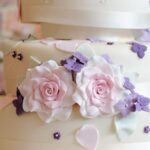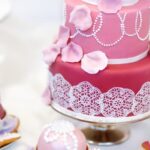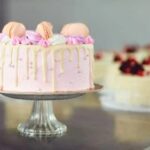The art of cake decorating is a truly remarkable skill that transforms ordinary desserts into awe-inspiring works of art. A cake decorator possesses the ability to take a simple, blank canvas and transform it into a visually stunning masterpiece.
Their creativity knows no bounds as they skillfully employ various techniques to create intricate designs, delicate sculptures, and vibrant patterns. Whether it’s a wedding cake adorned with elegant fondant flowers or a whimsical birthday cake featuring meticulously piped buttercream frosting, the work of a cake decorator never fails to captivate and amaze.
Cake decorators possess an array of skills and techniques that make their creations stand out from the crowd. From piping intricate details to sculpting elaborate figures with fondant, these artists are masters in their craft.
They understand how to combine colors, textures, and flavors in perfect harmony, resulting in cakes that are not only visually appealing but also deliciously satisfying. With their steady hand and attention to detail, they can create stunning icing designs that seemingly defy gravity and bring cakes to life.
To bring their artistic visions to fruition, cake decorators rely on a variety of tools and equipment specially designed for their trade. Piping bags filled with different types of tips allow them to create delicate borders and decorative accents with ease. Spatulas enable them to smoothly apply icing or ganache onto the surface of each layer.
Stencils help add intricate patterns or images while specialized molds allow for unique shapes and designs. With these essential tools at their disposal, cake decorators are able to turn dreams into reality one delectable creation at a time.
The Skills and Techniques of a Cake Decorator
Cake decorating is an art form that requires a unique set of skills and techniques. A cake decorator must possess a keen eye for design, precision in execution, and creativity to bring their vision to life. One of the fundamental skills of a cake decorator is piping.
Piping involves using a piping bag filled with icing to create intricate designs and patterns on the surface of the cake. From elegant swirls and rosettes to delicate lacework and flowers, piping adds a touch of sophistication and artistry to any cake.
Another technique commonly employed by cake decorators is fondant sculpting. Fondant is a smooth, pliable icing that can be rolled out and draped over cakes to create a clean canvas for intricate designs. Cake decorators use tools such as sculpting tools, cutters, and molds to shape fondant into various shapes, characters, or even entire scenes. Fondant sculpting allows for limitless creativity and opens up endless possibilities in cake design.
In addition to piping and fondant sculpting, cake decorators also utilize various icing designs to enhance the visual appeal of their creations. Techniques such as buttercream ruffles, ombre effects, marbling, lattice work, and brush embroidery are just a few examples of how decorators can elevate the appearance of their cakes. These icing designs add texture, depth, and dimension to the overall look of the cake.
| Technique | Description |
|---|---|
| Piping Buttercream Roses | Create beautiful roses using buttercream icing in different colors. |
| Fondant Ruffles | Add delicate ruffles made from fondant along the sides of the cake. |
| Ombre Effect | Blend different shades of icing to create a gradient effect on the cake. |
| Marbling | Swirl two or more colors of icing together to create a marbled effect. |
| Brush Embroidery | Create intricate lace-like patterns using thin, brush-strokes of royal icing. |
Mastery of these skills and techniques allows cake decorators to transform a simple dessert into a work of art. It is through their expertise that they are able to bring joy and amazement to any occasion, whether it’s a wedding, birthday, or any other celebration. The next section will delve into the tools of the trade that cake decorators rely on to bring their creative visions to life.
Tools of the Trade
Cake decorators rely on a variety of tools and equipment to bring their artistic visions to life. These specialized tools not only assist in creating intricate designs but also ensure precision and attention to detail. Here is an overview of some essential tools utilized by professional cake decorators:
Piping Bags
A piping bag is a must-have tool for cake decorators. These bags, usually made of cloth or plastic, are used to pipe buttercream, royal icing, or whipped cream onto the cakes. They come in various sizes and can be fitted with different decorating tips to create different shapes and patterns.
Spatulas
Spatulas are versatile tools that help cake decorators spread and smooth icing onto cakes. Offset spatulas are commonly used for even coverage on larger surfaces, while straight spatulas are perfect for smaller details like spreading fillings and getting into corners.
Stencils
Stencils are invaluable for creating flawless designs on cakes. From intricate lace patterns to whimsical characters, stencils allow decorators to achieve consistent results with ease. Commonly made from food-safe materials like plastic or silicone, stencils can be airbrushed or dusted with edible powders to add texture and detail.
Specialized Molds
Specialized molds have become increasingly popular among cake decorators. These molds, made from silicone or other food-grade materials, come in a wide array of shapes and sizes. Decorators can use them to create unique accents such as flowers, bows, or other decorative elements that add depth and dimensionality to their cakes.
While these tools are essential for cake decorating, it’s important to note that creativity and skill play just as crucial of a role in creating stunning designs. Aspiring cake decorators should familiarize themselves with these tools and practice using them effectively in order to bring their artistic ideas to life on delicious canvases.
Getting Started
Training Options
For individuals interested in pursuing a career as a cake decorator, there are several training options available to consider. One of the most common routes is attending a culinary school or institute that offers specialized programs in baking and pastry arts. These programs typically include coursework in cake decorating techniques, color theory, and cake design. Students will also have the opportunity to gain hands-on experience by working in professional kitchens or bakeries.
Another option is to pursue an apprenticeship or internship with an experienced cake decorator or bakery. This provides aspiring cake decorators with the opportunity to learn directly from seasoned professionals while gaining practical skills and knowledge in a real-world setting. Through apprenticeships, individuals can develop their technique, learn about different styles and trends, and understand the operations of running a successful cake decorating business.
Self-Learning Resources
In addition to formal training options, self-learning resources can be invaluable for those interested in becoming a cake decorator. Online tutorials, blogs, and YouTube channels provide step-by-step instructions on various cake decorating techniques.
These resources often include video demonstrations and detailed explanations that allow beginners to follow along and practice at their own pace. Popular online platforms even offer courses specifically tailored to aspiring cake decorators, where participants can receive feedback from instructors and connect with fellow students.
Books and magazines dedicated to cake decorating are another valuable resource for self-learners. These publications often feature instructional guides, inspiring designs, and tips from renowned cake decorators. By studying these materials and experimenting with different techniques, individuals can gradually hone their skills and develop their unique style as a decorator.
Considerations
Before embarking on a career as a cake decorator, it’s important to consider certain factors that may impact one’s success in the field. Attention to detail is crucial for achieving precise piping work and intricate designs. Additionally, physical stamina is necessary as long hours of standing and working with heavy cake tiers can be physically demanding.
It’s also worth noting that building a reputation as a cake decorator takes time, effort, and perseverance. Starting out as an assistant or junior decorator in a bakery can provide valuable experience and industry contacts. Taking on small projects to build a portfolio is another effective way to showcase skills and attract potential clients.
Ultimately, becoming a cake decorator requires passion, creativity, and continuous learning. By combining formal training with self-learning resources and gaining practical experience, aspiring decorators can set themselves on the path towards a rewarding career in the world of cake decorating.
A Day in the Life of a Cake Decorator
Being a cake decorator is not just about creating beautiful designs on cakes; it involves a whole world of creativity, dedication, and passion. A day in the life of a cake decorator is filled with exciting challenges and unique processes that bring their creations to life.
One of the first things that a cake decorator does in their day is to gather inspiration for their designs. They may browse through magazines, visit art galleries, or explore social media platforms to stay up to date with the latest trends and techniques. Once they have an idea in mind, they begin sketching and brainstorming different design concepts.
After finalizing the design, cake decorators will start preparing the cakes themselves. This includes baking the layers, leveling them to create an even surface, and applying fillings such as buttercream or ganache. Next comes the crumb coat – a thin layer of icing that seals in crumbs before applying the final layer of frosting.
Now comes the most exciting part – decorating the cake. Cake decorators use various techniques such as piping, fondant sculpting, and working with edible decorations to bring their vision to life. Piping allows them to create intricate patterns and designs using different nozzles on piping bags filled with buttercream or royal icing. Fondant sculpting enables them to create three-dimensional shapes and figures by molding colorful sugar paste.
In addition to these techniques, many cake decorators also excel in icing designs. They carefully apply patterns and textures using specialized tools like combs or stencils. Some decorators even incorporate airbrushing techniques to add gradients or gradients of colors for an even more artistic touch.
Throughout this process, cake decorators also face various challenges. One common challenge is ensuring that their cakes are stable and structurally sound while still being visually appealing. They need to understand the properties of different batters and fillings so that they can assemble multi-tiered cakes without fear of collapse.
Another challenge is time management. Cake decorators often have multiple orders to fulfill within tight deadlines. They must develop excellent organizational skills to ensure that each creation is completed on time while maintaining the highest quality.
Despite these challenges, cake decorators are driven by their love for what they do. Their profession requires them to be detail-oriented, patient, and creative problem solvers. It is this dedication and passion that shines through in every cake they create, making each one a true work of art.
Types of Cakes and Occasions
Cake decorating is an art form that allows for endless creativity and expression. From simple buttercream cakes to elaborate fondant masterpieces, cake decorators have the ability to transform a plain dessert into a visually stunning centerpiece.
One of the key aspects that makes cake decorating so versatile is its ability to cater to different types of occasions. Whether it’s a wedding, birthday party, or graduation celebration, there are countless cake styles and designs that can be customized to suit any event.
Weddings are one of the most common occasions where elaborate cake designs are showcased. A wedding cake serves as a symbol of love and celebration, often reflecting the style and theme of the couple’s special day. Traditional tiered cakes with intricate piping or floral decorations are a timeless choice for weddings. However, modern trends have seen couples opting for unique and unconventional designs such as naked cakes, which feature layers of unfrosted cake with minimal decoration.
Birthdays are another occasion where cake decorators can truly let their creativity shine. Children’s birthday parties often call for themed cakes featuring popular characters or hobbies. From superhero-inspired creations to princess castles, these imaginative designs bring joy to young party-goers. For adults, milestone birthdays may be celebrated with elegant and sophisticated designs like metallic accents or hand-painted details.
Graduation ceremonies also provide an opportunity for memorable cake designs. Whether it’s high school or college graduation, decorators can incorporate school colors or graduation cap motifs into their creations. Customized fondant sculptures representing graduates in their gowns and caps add a personal touch to these celebratory desserts.
| Occasion | Cake Styles/Designs |
|---|---|
| Weddings | Tiered cakes with intricate piping or floral decorations; naked cakes |
| Birthdays | Themed cakes featuring popular characters or hobbies; elegant and sophisticated designs for milestone birthdays |
| Graduations | Cakes with school colors or graduation cap motifs; fondant sculptures of graduates |
Trends in Cake Decorating
Drip Cakes: A Sweet Sensation
One of the latest trends in cake decorating is the popularity of drip cakes. Drip cakes are known for their elegantly flowing drips of ganache or icing that cascade down the sides of a cake, creating a visually stunning effect. This technique adds a touch of whimsy and playfulness to any cake design, making it a favorite choice for birthdays, weddings, and other celebrations.
To create the perfect drip cake, cake decorators carefully control the consistency of the drip icing to ensure it flows smoothly and evenly. They use various techniques such as spooning or pouring the mixture over the top edge of the cake, allowing it to naturally create beautiful drips down the sides. Drip cakes can be customized with different flavors and colors, adding an extra layer of creativity to these delectable creations.
Geode-Inspired Designs: A Slice of Natural Beauty
Another trend that has taken the cake decorating world by storm is geode-inspired designs. Drawing inspiration from natural crystal formations found in geodes, cake decorators are creating intricate designs using sugar crystals and edible gem-like decorations. These geode-inspired creations showcase vibrant colors and stunning textures that resemble precious stones like amethysts or quartz.
To achieve this look, cake decorators begin by carving out spaces in the cake where they will pour colorful isomalt or rock candy crystals. These crystals create a mesmerizing effect when they catch the light and give the illusion of real mineral formations within the layers of the cake. Geode-inspired cakes are often used as centerpieces for weddings and special events due to their unique beauty and ability to captivate audiences.
Hand-Painted Decorations: Edible Masterpieces
Innovative techniques in cake decorating have also brought about a resurgence in hand-painted decorations on cakes. Cake decorators skilled in painting with food-safe colors and edible paints are creating intricate designs that resemble traditional works of art. These hand-painted creations allow for a limitless range of possibilities, from delicate floral patterns to elaborate landscapes.
To create hand-painted decorations, cake decorators use brushes specifically designed for food use and techniques similar to those used in other forms of painting. They carefully apply layers of edible paint onto a fondant-covered surface or directly onto the cake itself. The result is a one-of-a-kind masterpiece that adds a touch of elegance and sophistication to any event.
As trends in cake decorating continue to evolve, cake decorators push the boundaries of creativity, introducing new techniques, designs, and flavors that enthrall both the eyes and the taste buds. By staying on top of these trends, cake decorators are able to offer their clients enchanting and visually appealing creations that make any occasion truly memorable.
The Business of Cake Decorating
While cake decorating is undoubtedly an art form, it also encompasses a business aspect that allows professional cake decorators to turn their passion into a profitable career. In this section, we will delve into the various considerations and strategies involved in running a successful cake decorating business, including pricing, marketing, and building a clientele.
One of the key aspects of running a cake decorating business is establishing appropriate pricing strategies. Cake decorators must consider factors such as ingredients, complexity of design, and time spent creating each cake. Pricing should not only cover costs but also allow for profit and growth.
Many decorators use a formula that takes into account the cost of ingredients, overhead expenses, and desired profit margin. It is crucial to strike a balance between competitive pricing and ensuring fair compensation for the skill and effort put into each creation.
Marketing techniques play an essential role in attracting customers to a cake decorating business. Social media platforms like Instagram and Facebook have become instrumental in showcasing creations and reaching potential clients. Posting high-quality images regularly can help build an online presence that appeals to those seeking visually stunning cakes for special occasions. Additionally, word-of-mouth referrals from satisfied customers can be invaluable in growing a client base.
Building a clientele requires consistent quality work coupled with excellent customer service. Establishing relationships with local event planners, wedding venues, and other industry professionals can lead to valuable recommendations. Providing exceptional customer experiences through prompt communication, reliability, and attention to detail encourages repeat business and positive reviews. Networking within the baking community through collaborations or participating in industry events can also help generate visibility and referral opportunities.
Running a cake decorating business involves much more than just artistic talent; it requires understanding the dynamics of the market and implementing effective strategies. By carefully considering pricing structures, using appropriate marketing techniques, and building strong relationships with clients and industry professionals alike, talented cake decorators can establish thriving businesses that allow them to share their creativity with the world.
Exposure and Recognition
Exposure and recognition are crucial for cake decorators to establish themselves in the industry and showcase their skills and creativity. There are various avenues available for cake decorators to gain visibility, build their reputation, and attract potential clients.
Participating in competitions is one effective way to showcase talent and gain exposure. Cake decorating competitions provide a platform for decorators to display their skills, receive feedback from experts in the field, and potentially win awards or prizes that can bolster their career.
In addition to competitions, creating an online presence is essential in today’s digital age. Utilizing social media platforms such as Instagram, Facebook, and Pinterest allows cake decorators to showcase their portfolio of work, interact with potential clients, and connect with other professionals in the industry. By regularly sharing high-quality photos of their cakes along with behind-the-scenes glimpses into their creative process, decorators can build a strong online following that can lead to increased exposure and opportunities.
Collaborating with other professionals also provides cake decorators with additional exposure and recognition within the industry. This can involve collaborating with event planners, caterers, photographers, or even other cake decorators on styled shoots or events. By offering their expertise and artistic skills in collaboration with others, decorators can expand their network of contacts, be featured in publications or blogs, and have their work showcased alongside other talented individuals.
Overall, gaining exposure and recognition as a cake decorator requires actively seeking out opportunities both offline and online. Whether through competitions, building an online presence on social media platforms, or collaborating with other professionals/community members in the field – these avenues provide valuable opportunities for recognition that can ultimately lead to a successful career as a cake decorator.
Conclusion
In conclusion, cake decorators play a vital role in the creation of memorable and visually captivating desserts. From birthdays to weddings to graduations, these skilled artists use their diverse skillsets and techniques to transform plain cakes into works of art. Through piping, fondant sculpting, and icing designs, they are able to create intricate and stunning decorations that elevate the overall aesthetic of a cake.
The tools of the trade are essential for cake decorators to bring their visions to life. Piping bags, spatulas, stencils, and specialized molds are just a few examples of the equipment these professionals utilize on a daily basis. With these tools in hand, cake decorators are able to manipulate different materials and mediums to achieve their desired designs.
Becoming a cake decorator requires dedication and passion. Whether through training programs, apprenticeships, or self-learning resources, individuals interested in pursuing this career must be willing to invest time and effort in honing their craft.
The daily routines of cake decorators can vary greatly depending on the specific occasion or project they are working on. Challenges may arise along the way, but it is through their creativity and perseverance that these professionals are able to overcome obstacles and deliver extraordinary results.
In this ever-evolving industry, trends in cake decorating continue to emerge. Drip cakes, geode-inspired designs, and hand-painted decorations are just a few examples of the innovative techniques being utilized by cake decorators around the world. By keeping up with these trends and pushing boundaries with their own creations, cake decorators are constantly pushing the limits of what is possible in dessert design.
Ultimately, it is important for readers to appreciate the artistry behind cake decorating. It takes immense talent and skill to transform cakes into beautiful masterpieces that leave lasting impressions on those who see them.
So next time you come across an intricately designed cake at a special event or even online, take a moment to admire the craftsmanship that went into creating it. Cake decorators truly are the unsung heroes of the kitchen, and their contribution to creating memorable and visually captivating desserts should never be overlooked.
Frequently Asked Questions
What is a cake decorator called?
A cake decorator is commonly known as a pastry chef or a cake artist. These individuals are skilled in the art of decorating cakes, using various techniques and tools to create visually appealing designs on the surface of the cake.
They may specialize in different areas such as fondant work, sugarcraft, or buttercream piping, and their expertise often extends beyond just cakes to other baked goods like cupcakes and pastries.
What is the difference between a cake artist and a cake decorator?
While both a cake artist and a cake decorator share the same fundamental skillset, there are subtle differences between them. A cake artist is typically someone who not only possesses technical mastery of various decorating techniques but also brings a high level of creativity and artistic flair to their work.
They may be more inclined towards elaborate, customized creations that involve sculpting or creating intricate details by hand. On the other hand, a cake decorator may focus more on executing pre-designed concepts or reproducing specific decorations with precision.
What is the personality of a cake decorator?
The personality traits commonly found in cake decorators can vary, but some characteristics tend to be prevalent within this profession. Attention to detail is crucial for a successful cake decorator since they need to carefully follow design instructions while ensuring each element is precisely executed. Patience is also key as decorating cakes can be time-consuming and intricate work that requires meticulous concentration.
Creativity is essential, allowing them to come up with unique designs or adapt existing concepts to suit different occasions. Furthermore, strong organizational skills help them manage their time effectively and handle multiple orders simultaneously without compromising quality. Lastly, good communication skills are important for understanding clients’ preferences and maintaining professionalism throughout the process of designing and delivering the desired product.

Welcome to my blog about home and family. This blog is a place where I will share my thoughts, ideas, and experiences related to these important topics. I am a stay-at-home mom with two young children. I hope you enjoy reading it! and may find some helpful tips and ideas that will make your home and family life even better!





